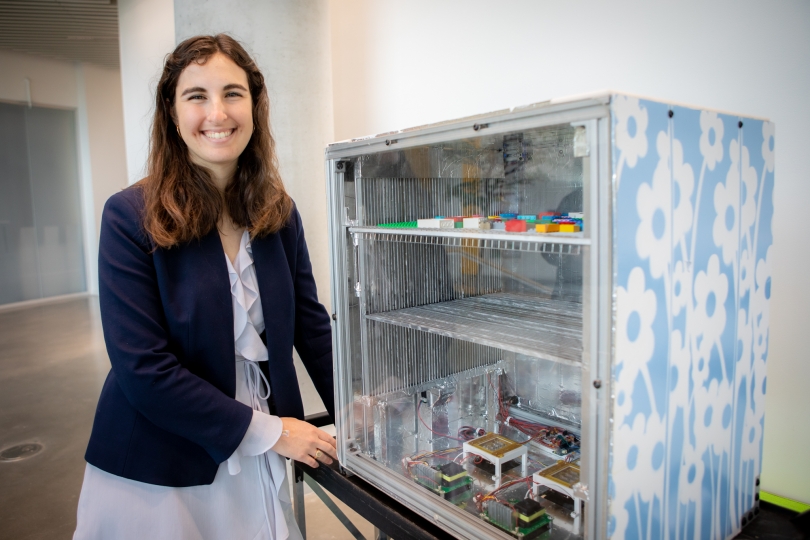Katie Barkin, S.B. '22, built an ultraviolet sanitation device for small objects such as children's toys for her senior capstone project. (Eliza Grinnell/Harvard SEAS)
Engineering Design Projects (ES 100), the capstone course at the Harvard John A. Paulson School of Engineering and Applied Sciences, challenges seniors to engineer a creative solution to a real-world problem.
Good Clean Fun: Modernizing Toy Sanitation
Katie Barkin, S.B. ‘22, mechanical engineering
Where’d your project idea come from?
I knew that I was interested in consumer product design, so I met with my current advisor and reader, Steven Cortesa and Katia Bertoldi. One of the things that Katia mentioned is that the areas that are often under-engineered are women’s areas. She has several young kids, so we started thinking about things that are needed in kids’ spaces, items that might not exist yet or might not exist as well as they should yet.
How does the sanitizing process work?
Toys are held aloft on a slotted platform so that all sides of the toys except the parts touching the slots are exposed. An ultraviolet light turns on, sanitizing the exposed areas. The platform then moves, depositing the toys on another platform, then the ultraviolet sanitation happens again. Because both platforms are made of thin slats, and the two platforms move through each other, any surface area that was blocked from sanitation in the first cycle is exposed in the second cycle. This means that between the two cycles. all parts of the toys get sanitized.
How did your project come together over the course of the year?
I prototyped three designs. I spent the first couple weeks doing a lot of background research and trying to figure out how I was going to move these toys around. I spent a lot of time thinking of different designs and making very quick prototypes. By October I’d made my mechanism decision, and from there it was about subsystem design. I was done with the design by Christmas, and over Christmas break I really updated my computer-aided design (CAD) model and made sure that it had everything in there. Then I was able to come back about 10 days early in January and build the whole thing, and even that took a lot more time than expected. I really spent this last month on the electronics, the aesthetics and the testing. I tested using E. coli bacteria, but UV radiation has been shown to be effective at sanitizing a wide range of common bacteria, viruses and germs, including COVID-19.
What part did you enjoy the most?
Adding those final decorative touches was really rewarding. When I finally installed the sides permanently and closed it up, it was so rewarding to look at it and say, ‘This is a machine that I made.’ Looking at the inside, there isn’t a single thing in there that I can’t explain my reasoning for. I know every single question that someone could ask me.
What part was the most challenging?
One of the reasons that I was so ahead in the fall was that I was convinced that this was not going to work. I had convinced myself that the light was not going to reflect up and around, and it was not going to actually hit the sides. I had several different attack plans based on which way it failed, so I wanted to start that testing really early so that I could figure out how to fix things based on which way it failed. It ended up failing in one of the ways that I had not expected at all, and it was a completely moot point. You run those first tests, and it’s so nervewracking. Either it’s going to work, and I’m done early, or it’s not going to work, and I’m going to be cramming stuff in until the last minute.
What skills did you gain through your project?
It was definitely an interdisciplinary project in a way that I didn’t necessarily anticipate at the beginning. I learned a lot about biology that I didn’t know anything about. I knew the electronic stuff, but had just taken one class, and this went way beyond what I learned in that one class to do some really cool electronic stuff. I feel like I’ve become a much better engineer throughout this process.
Press Contact
Matt Goisman | mgoisman@g.harvard.edu
